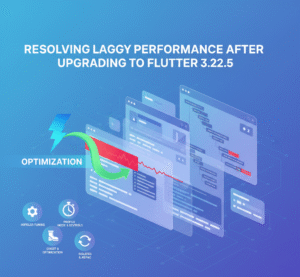In the fast-evolving landscape of mobile app development, Flutter has emerged as a revolutionary framework that enables developers to build natively compiled applications for mobile, web, and desktop from a single codebase. Since its official release by Google in 2018, Flutter has gained tremendous popularity due to its flexibility, performance, and the ability to create visually stunning user interfaces across multiple platforms.
However, mastering Flutter’s widget-based architecture and Dart programming language can present a steep learning curve, especially for beginners or designers transitioning to development. This is where Flutter UI editors come into play – specialized tools designed to simplify the process of creating Flutter applications through visual interfaces, drag-and-drop functionality, and code generation capabilities.
UI editors serve as a bridge between design and development, allowing teams to:
- Accelerate development cycles by reducing the time spent writing boilerplate code
- Lower the entry barrier for non-developers to contribute to app creation
- Streamline the design-to-code workflow by minimizing handoff friction
- Prototype rapidly to validate concepts before committing to full development
- Focus on business logic rather than UI implementation details
As the Flutter ecosystem continues to mature, several UI editors have emerged, each with its own approach, feature set, and target audience. In this comprehensive guide, we’ll explore and compare three prominent Flutter UI editors: FlutterFlow, FlutterViz, and Blup. We’ll examine their features, pricing models, strengths, limitations, and ideal use cases to help you make an informed decision about which tool best suits your specific needs.
Detailed Comparison of Flutter UI Editors
FlutterFlow
Overview: FlutterFlow is a powerful visual development platform that allows users to build Flutter applications with minimal coding. It provides a comprehensive environment for creating high-quality, customized apps through visual development tools, pre-designed UI elements, and code export capabilities.
Key Features:
- Drag-and-drop UI builder with 50+ customizable components
- Visual state management
- Built-in authentication systems
- Database integration (Firebase, Supabase, Xano)
- API integration capabilities
- Animation builder
- Custom code insertion
- Code export functionality
Pricing Model:
- Free tier with limited features and FlutterFlow branding
- Paid plans starting from approximately $30/month for individuals
- Higher-tier plans for teams and enterprises
- Requires payment to export clean Flutter code
Strengths:
- Excellent for mocking UIs and creating prototypes
- Ideal for users without extensive Flutter widget knowledge
- Strong integration with Firebase and other backend services
- Comprehensive environment for building entire applications
- Regular updates and active development
Limitations:
- Often generates messy code that may require refactoring
- Can be expensive as projects scale
- Steeper learning curve than expected
- Limited for web development compared to mobile
- Works best with specific database solutions (Firebase, Supabase, Xano)
Best Use Cases:
- Rapid prototyping and proof of concept development
- Non-technical founders creating MVPs
- Teams with limited Flutter expertise
- Projects heavily integrated with Firebase
- Applications with standard UI patterns and workflows
FlutterViz
Overview: FlutterViz is a free drag-and-drop UI builder specifically designed for Flutter apps. It offers an easy-to-use interface with a focus on UI creation and code export, making it accessible to developers of all skill levels.
Key Features:
- Drag-and-drop interface with 50+ customizable widgets
- Free source code download
- UI Kit creation capabilities
- Widget customization options
- One-click code export
- Lifetime free updates
Pricing Model:
- Free for lifetime with regular updates
- No premium tiers or hidden costs
Strengths:
- Completely free with no limitations on code export
- Simple and intuitive interface
- Focused specifically on UI creation
- Ability to create industry-specific UI Kits
- Low barrier to entry for beginners
Limitations:
- Stability issues reported by some users (disconnections and data loss)
- Limited functionality compared to full-featured platforms
- Primarily focused on UI rather than full application development
- Less robust backend integration options
- Smaller community and support network
Best Use Cases:
- UI prototyping and mockups
- Learning Flutter widget structures
- Creating reusable UI components and kits
- Small projects with standard UI requirements
- Developers looking to speed up UI implementation
Blup
Overview: Blup is a comprehensive low-code Flutter IDE that combines visual development tools with powerful backend integration capabilities. It positions itself as the ultimate IDE for Flutter app development, offering a complete environment for building, testing, and deploying Flutter applications.
Key Features:
- BlupDesigner: Drag-and-drop UI builder
- Blup Logic: Visual logic creator for app functionality
- Blup Backend: GUI-based database for data management
- Real-time collaboration tools
- Integration with existing Flutter projects
- One-click publishing to App Store and Play Store
- Visual development environment
Pricing Model:
- Specific pricing details not widely published
- Appears to offer both free and paid options
Strengths:
- Comprehensive environment covering UI, logic, and backend
- Real-time collaboration features for team development
- Seamless integration with existing Flutter projects
- Simplified app publishing process
- Focus on Flutter-specific optimization
- Visual logic creation reduces coding requirements
Limitations:
- Newer platform with potentially less community support
- Less established track record compared to alternatives
- May have a learning curve for complex application logic
Best Use Cases:
- MVP development for startups
- Teams transitioning from design to development
- Projects requiring rapid iteration and testing
- Applications with standard backend requirements
- Developers looking for an all-in-one Flutter solution
Visual UI Editors vs. Manual Coding
When to Use Visual UI Editors
Advantages:
- Rapid Prototyping: Visual editors excel at quickly creating functional prototypes and proof of concepts.
- Lower Entry Barrier: They make Flutter development accessible to designers and non-developers.
- Visualization: Seeing the UI as you build it reduces the design-to-code gap.
- Time Efficiency: For standard UI patterns, visual editors can significantly reduce development time.
- Team Collaboration: Visual interfaces can improve communication between designers and developers.
Ideal Scenarios:
- Early-stage product development and validation
- Creating mockups for client approval
- Learning Flutter widget structures and relationships
- Projects with tight deadlines and standard UI requirements
- Teams with mixed technical expertise
When to Prefer Manual Coding
Advantages:
- Code Quality: Hand-written code is typically cleaner and more maintainable.
- Performance Optimization: Manual coding allows for fine-tuning performance.
- Customization: Complex or unique UI elements often require custom code.
- Control: Direct coding provides complete control over implementation details.
- Long-term Maintenance: Custom code is often easier to maintain and extend over time.
Ideal Scenarios:
- Production-level applications with complex requirements
- Projects requiring custom animations or interactions
- Applications with strict performance requirements
- Teams with strong Flutter development expertise
- Long-term projects that will require ongoing maintenance
Hybrid Approaches
Many successful Flutter projects adopt a hybrid approach:
- Use visual editors for rapid prototyping and initial UI development
- Export the generated code as a starting point
- Refine and optimize the code manually for production
- Leverage visual tools for standard components while custom-coding complex features
This approach combines the speed of visual development with the quality and control of manual coding.
Decision Framework: Choosing the Right Flutter UI Editor
Questions to Consider
- 1.
- 2.
- 3.
- 4.
- 5.
Recommendations by User Profile
For Beginners:
- Start with FlutterViz to understand Flutter widgets and UI structure
- Progress to FlutterFlow or Blup as you gain confidence
- Gradually learn manual coding alongside visual development
For Startups and Small Teams:
- Consider Blup for its comprehensive approach to MVP development
- Use FlutterFlow if Firebase integration is important
- Adopt a hybrid approach as your product matures
For Experienced Developers:
- Use visual editors selectively for rapid prototyping
- Consider FlutterViz for creating reusable UI components
- Maintain manual coding practices for core functionality
For Enterprises:
- Evaluate FlutterFlow’s team capabilities for collaborative development
- Consider Blup for projects requiring real-time collaboration
- Implement quality control processes for generated code
Conclusion
Flutter UI editors represent a significant advancement in cross-platform app development, bridging the gap between design and implementation while reducing development time and technical barriers. Each of the tools we’ve examined—FlutterFlow, FlutterViz, and Blup—offers unique advantages and is suited to different use cases and user profiles.
The ideal approach often depends on your specific requirements, technical expertise, budget, and project timeline. For many teams, a hybrid approach that leverages visual development for rapid prototyping and standard components, combined with manual coding for optimization and custom features, provides the best balance of efficiency and quality.
As the Flutter ecosystem continues to evolve, we can expect these UI editors to become even more powerful and sophisticated, further simplifying the app development process while maintaining the performance and flexibility that make Flutter such a compelling framework.
Ultimately, the best tool is the one that helps you achieve your specific goals efficiently. We encourage you to experiment with different options, consider your team’s unique needs, and find the approach that works best for your Flutter development journey.
What is your primary goal?
- Learning Flutter → FlutterViz or manual coding
- Creating a production app → FlutterFlow, Blup, or manual coding
- UI prototyping only → FlutterViz or FlutterFlow
What are your backend requirements?
- Firebase integration → FlutterFlow
- Simple data management → Blup with BlupSheets
- Complex custom backend → Consider manual coding with API integration
What is your budget?
- Limited or no budget → FlutterViz
- Moderate budget → FlutterFlow or Blup
- Enterprise budget → Consider FlutterFlow’s team plans or custom solutions
What is your project timeline?
- Need rapid prototyping → Any visual editor
- Tight deadline for MVP → FlutterFlow or Blup
- Long-term development → Consider manual coding or a hybrid approach
What is your technical expertise?
- Limited coding experience → FlutterFlow or Blup
- UI/UX designer → FlutterViz or FlutterFlow
- Experienced Flutter developer → Consider manual coding with occasional use of UI editors






